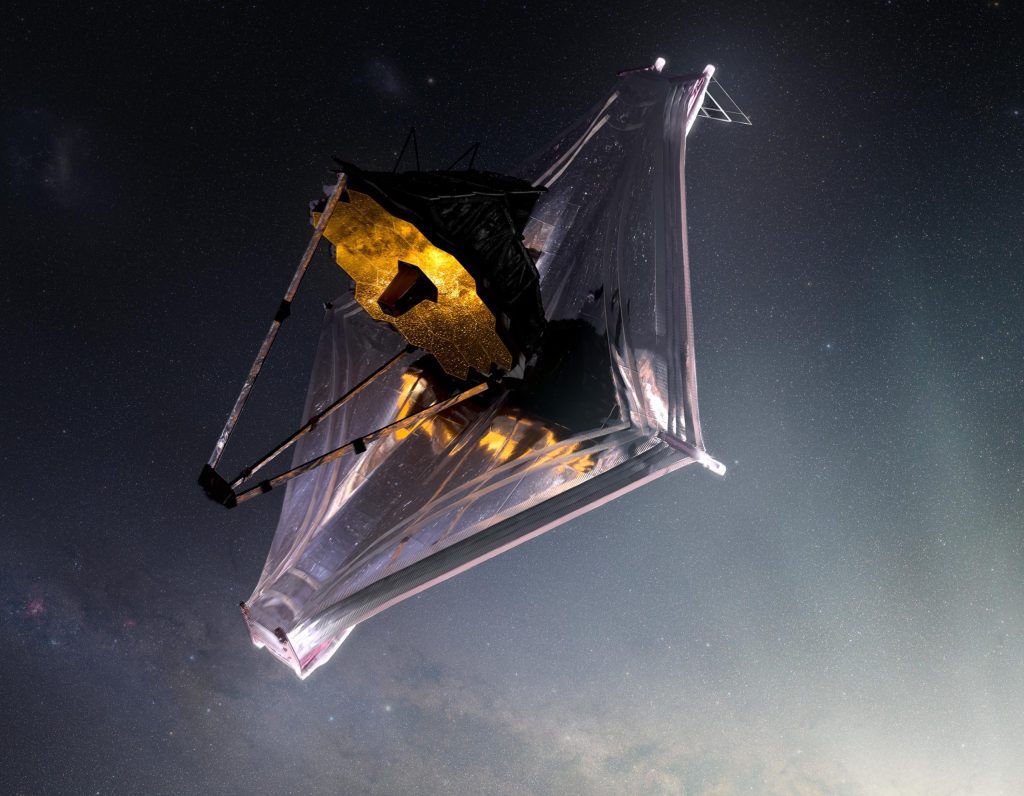

Representación artística del telescopio espacial James Webb. Crédito: NASA GSFC/CIL/Adriana Manrique Gutiérrez
Equipo del Telescopio Espacial Webb sigue trabajando sobre mí puesta en marcha Es el último paso antes del inicio de las operaciones científicas en verano. Hace poco vimos la increíble foto de El agujero negro en el centro de nuestra galaxia, la Vía Lácteatomada por telescopio de horizonte de sucesos. Uno de los misterios de la astronomía moderna es cuán grande es cada uno galaxia Llegó a tener una centralidad gigante Agujero negroy cómo algunos de estos agujeros negros son sorprendentemente grandes incluso en los primeros tiempos del universo. Le pedimos a Roberto Maiolino, miembro del equipo de espectrómetro de infrarrojo cercano (NIRSpec) de Webb, que nos dijera cómo Webb ayudará a responder algunas de estas preguntas.
«Una de las áreas de descubrimiento más emocionantes que Webb está a punto de desbloquear es la búsqueda de agujeros negros primordiales en el universo primitivo. Estas son las semillas de los agujeros negros más masivos que los astrónomos han encontrado en los núcleos galácticos. La mayoría de las galaxias (quizás todas ) albergan agujeros negros en sus centros, y sus masas oscilan entre millones y miles de millones de veces la masa de nuestro Sol, estos agujeros negros supermasivos se han vuelto muy grandes al devorar la materia que los rodea y también al fusionar agujeros negros más pequeños.
«El último descubrimiento interesante es el descubrimiento de agujeros negros supermasivos, con masas de varios miles de millones de masas solares, que en realidad existían cuando el universo tenía solo unos 700 millones de años, una fracción de su edad actual de 13.800 millones de años. Esto es desconcertante. resultado, porque a edades tan tempranas no hubo tiempo suficiente para el desarrollo de agujeros negros tan masivos, según las teorías estándar. Se han propuesto algunos escenarios para resolver este misterio.
Una posibilidad es que los agujeros negros, causados por la muerte de la primera generación de estrellas en el universo primitivo, hayan acumulado material a un ritmo excepcionalmente alto. Otro escenario es que las nubes de gas primordiales, que aún no están enriquecidas con elementos químicos más pesados que el helio, podrían colapsar directamente para formar[{» attribute=»»>black hole with a mass of a few hundred thousand solar masses, and subsequently accrete matter to evolve into the hyper-massive black holes observed at later epochs. Finally, dense, nuclear star clusters at the centers of baby galaxies may have produced intermediate mass black hole seeds, via stellar collisions or merging of stellar-mass black holes, and then become much more massive via accretion.

This illustration shows the populations of known black holes (large black dots) and the candidate black hole progenitors in the early universe (shaded regions). Credit: Roberto Maiolino, University of Cambridge
“Webb is about to open a completely new discovery space in this area. It is possible that the first black hole seeds originally formed in the ‘baby universe,’ within just a few million years after the big bang. Webb is the perfect ‘time machine’ to learn about these primeval objects. Its exceptional sensitivity makes Webb capable of detecting extremely distant galaxies, and because of the time required for the light emitted by the galaxies to travel to us, we will see them as they were in the remote past.
“Webb’s NIRSpec instrument is particularly well suited to identify primeval black hole seeds. My colleagues in the NIRSpec Instrument Science Team and I will be searching for their signatures during ‘active’ phases, when they are voraciously gobbling matter and growing rapidly. In these phases the material surrounding them becomes extremely hot and luminous and ionizes the atoms in their surroundings and in their host galaxies.
“NIRSpec will disperse the light from these systems into spectra, or ‘rainbows.’ The rainbow of active black hole seeds will be characterised by specific ‘fingerprints,’ features of highly ionized atoms. NIRSpec will also measure the velocity of the gas orbiting in the vicinity of these primeval black holes. Smaller black holes will be characterized by lower orbital velocities. Black hole seeds formed in pristine clouds will be identified by the absence of features associated with any element heavier than helium.
“I look forward to using Webb’s unprecedented capabilities to search for these black hole progenitors, with the ultimate goal of understanding their nature and origin. The early universe and the realm of black holes seeds is a completely uncharted territory that my colleagues and I are very excited to explore with Webb.”
— Roberto Maiolino, professor of experimental astrophysics and director of the Kavli Institute for Cosmology, University of Cambridge
Written by:
- Jonathan Gardner, Webb deputy senior project scientist, NASA’s Goddard Space Flight Center
- Stefanie Milam, Webb deputy project scientist for planetary science, NASA’s Goddard Space Flight Center





More Stories
¿Cómo se hicieron los agujeros negros tan grandes y rápidos? La respuesta está en la oscuridad.
Una vaca marina prehistórica fue devorada por un cocodrilo y un tiburón, según los fósiles
El lanzamiento del cohete Falcon 9 de SpaceX se ha detenido a medida que se acercan dos importantes misiones de vuelos espaciales tripulados.